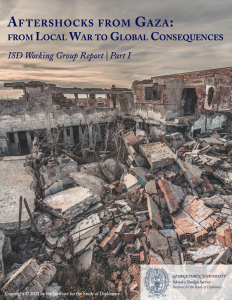
In the spring of 2025, the Institute for the Study of Diplomacy (ISD) convened the Schlesinger Series in Strategic Surprises and New Global Commons working group titled “Aftershocks from Gaza.” Over two meetings, participants examined the cascading regional and global effects of the October 7 Hamas attacks and Israel’s subsequent war in Gaza.
The participants analyzed the conflict in concentric circles—from its epicenter in Gaza, Israel, Lebanon, and Syria, to its reverberations across the Middle East and into global politics. At the forefront was the question of how the war has both exposed and accelerated tectonic shifts in regional power balances, US influence, and the international norms of armed conflict.
Click here to read part one of the report.
Executive Summary
The grotesque attacks by Hamas on October 7, 2023, and Israel’s subsequent military campaign in Gaza have upended long-standing assumptions about regional order. The Middle East’s previous reliance on a US-led security framework has given way to a fragmented, multi-aligned landscape in which middle powers pursue their interests, while the Palestinian issue—long marginalized—has returned to the center of regional and global diplomacy.
Israel has secured tactical military gains but at the cost of increasing diplomatic isolation, while conditions in Gaza have fueled global demands for a sustainable political solution. Iran, Hezbollah, and Syria face profound setbacks, while Turkey and the Arab Gulf states seek to expand influence without the means to dominate. China and Russia remain cautious players, unwilling or unable to shape the conflict’s outcome.
For the United States, the Gaza war poses a strategic dilemma. Despite efforts to broker ceasefires and secure hostages, Washington has been unable—or unwilling—to exert decisive leverage on Israel. The Biden and Trump administrations alike have struggled to articulate a coherent, sustainable strategy that balances US interests in security, energy, stability, and credibility.
The ISD Gaza Report is organized in two parts:
- Part I: A ground assessment of the regional shifts since October 7, with particular focus on Israel, Gaza, Lebanon, and Syria, as well as the reemergence of Palestine as the central unresolved question in Middle East politics, and the role of regional states.
- Part II: A deeper analysis of Iran’s position and prospects, scenarios for regional order, and US policy options, culminating in concrete recommendations for advancing stability while protecting US strategic interests.
Participants underscored that any durable path forward begins and ends with Palestine and the Palestinians. US policymakers must adapt to a regional order defined not by hegemonic control but by contested pluralism and assertive middle powers. Strategic clarity, consistent diplomacy, and credible leverage are essential if Washington hopes to pursue its interests amid the aftershocks from Gaza—and not merely react to them.
